|
Reminder:
An IDES representative will conduct small group meetings every 30 minutes in the Wilson Hall One East conference room (NE corner) each Friday from 11 a.m. to 1:30 p.m. from tomorrow through the end of March.
New furlough information, including an up-to-date Q&A section, appears on the furlough Web pages daily.
|
|
Thursday, March 13
2:30 p.m.
Theoretical Physics Seminar - Curia II
Speaker: T. Appelquist, Yale University
Title: Lattice Study of the Conformal Window in QCD-Like Theories
3:30 p.m.
DIRECTOR'S COFFEE BREAK - 2nd Flr X-Over
4 p.m.
Accelerator Physics and Technology Seminar - Curia II (NOTE LOCATION)
Speaker: A. Zlobin, Fermilab
Title: Nb3Sn Accelerator Magnet R&D and LHC Luminosity Upgrades
Friday, March 14
3:30 p.m.
DIRECTOR'S COFFEE BREAK - 2nd Flr X-Over
4:00 p.m.
Joint Experimental-Theoretical Physics Seminar - One West
Speaker: J. Coleman, Stanford Linear Accelerator Center
Title: New Results on Charm Mixing from BaBar
Saturday, March 15
8 p.m.
Fermilab Arts Series - Ramsey Auditorium
Tickets: $25/$13
Cherish the Ladies
Click here for NALCAL,
a weekly calendar with links to additional information.
|
Thursday, March 13
- Tomato Florentine
- *Pork BBQ sandwich
- Chimichangas
- Smart cuisine: Chicken marsala
- Smoked turkey melt
- Assorted pizza slices
- SW chicken salad w/roasted corn salsa
*Carb restricted alternative
Wilson Hall Cafe menu |
|
Thursday, March 13
Dinner
- Closed
Wednesday, March 19
Dinner
- Trout almondine
- Lemon scented rice
- Vegetable of the season
- Amaretto cheesecake
Chez Leon menu
Call x4598 to make your reservation. |
|
|
CDMS model translates
data to light, sound
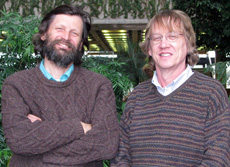
Karl Ramberg, left, was inspired to create a musical version of the CDMS detector from the dark matter research conducted by his brother, Fermilab physicist and CDMS collaborator Erik.
Karl Ramberg sometimes incorporates music into his artwork. But a trip with his brother, Fermilab physicist Erik Ramberg, added science to his palette. Karl, with the help of scientists, produced a full-scale, plastic model of a dark matter detector that translates its data into light and sound.
"The end result is that you get an experience, aurally and visually, of subatomic affects," Karl said. "You get a better understanding of what the data is saying."
The musical detector, a YouTube sensation, is modeled after the real Cryogenic Dark Matter Search, an underground experiment searching for dark matter particles. The actual CDMS experiment detects and records the energies of particles that strike its five towers. The model takes that one step further, expressing the data in color and tone according to particles and their properties.
The idea for the model was inspired by a trip to the Soudan, Minn. mine that houses the CDMS experiment, where Erik, a CDMS collaborator, took shifts.
"I told him I'd go with him," Karl said. "The whole notion of being at the bottom of an abandoned iron mine - there is something kind of romantic or mysterious about it."
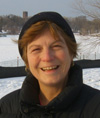 |
| CDMS collaborator and University of Minnesota professor Prisca Cushman. |
After spending the better part of a week in the mine, Karl had an idea to turn the detector into functional multimedia artwork. So, with the help of his brother and CDMS collaborator and University of Minnesota professor Prisca Cushman, Karl built a model detector to scale.
"I spent a lot of time programming it. I had to get CDMS files in the proper format and figure out what sounds good," Cushman said.
Cushman translated the data for an hour each night, between 9-10 p.m. in her attic. She filmed the YouTube video of the musical model and uploaded it online with the help of her neighbor's 10-year-old nephew.
Eventually Cushman said she and the Rambergs would like to place the model or a similar one in a science or university museum.
"This could be a great outreach tool," Cushman said. "It has a lot of potential to spark people's interest."
-- Rhianna Wisniewski
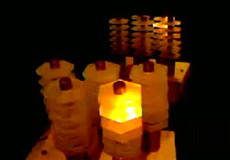
Click on the image to watch the five-minute video of the musical model of the CDMS detector on YouTube.
|
Physicists: After 30 years of study, rare particle confirms prediction
From University of Florida News,
March 10, 2008
High-energy physicists devoted to recreating the conditions at the beginning of the universe have for the first time observed a new way to produce those basic particles of atoms, protons and neutrons.
Confirming a decades-old prediction, the physicists with the CLEO collaboration say they observed a rare and extremely short-lived subatomic particle with the unusual name of "charmed-strange meson" decay into a proton and anti-neutron.
Detection of the event, which the collaboration made public Sunday at http://arxiv.org/, was attributed to John Yelton, a physicist at the University of Florida, one of many institutions that are part of the CLEO collaboration.
"It's the sort of thing that, for many years, people have known should happen," Yelton said. "What we have done is show that it does, and how often."
Read more
|
Searching for a tiny new dimension, curled up like the universe before the Big Bang
From Science Daily,
March 12, 2008
The universe as we currently know it is made up of three dimensions of space and one of time, but researchers in the Department of Physics and the Department of Electrical and Computer Engineering at Virginia Tech are exploring the possibility of an extra dimension.
Sound like an episode from the "Twilight Zone?" Almost, but not quite; according to John Simonetti, associate professor of physics in the College of Science and Michael Kavic, graduate student and one of the investigators on the project.
"The idea we're exploring is that the universe has an imperceptibly small dimension (about one billionth of a nanometer) in addition to the four that we know currently," Kavic said. "This extra dimension would be curled up, in a state similar to that of the entire universe at the time of the Big Bang."
Read more
|
|
|
Violating lepton
flavor with SUSY
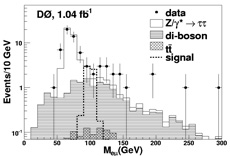
This figure demonstrates the predicted experimental signature of a sneutrino decay among the Standard Model background processes. The invariant electron-plus-muon mass would appear as a peak, as indicated in the figure.
Extensive experimental studies reveal three unique generations, or flavors, of leptons: electrons, muons, taus and their associated neutrinos. Each lepton flavor should remain unique within interactions, and the number of each flavor should remain constant. This rule indicates, for example, that each electron must be produced with a positron or with an electron antineutrino, but an electron and a muon cannot be produced in pairs without additional particles. A violation of lepton flavor would indicate a clear sign of new physics beyond the Standard Model. DZero collaborators from the University of Science and Technology of China are now publishing a comprehensive test of lepton flavor violation.
Supersymmetric extensions to the Standard Model suggest each known particle should have a superpartner. The quantum number of that superpartner's spin would differ by one-half. Theorists at USTC hypothesized that single heavy sneutrino particles (0-spin superpartners for ordinary neutrinos) production was possible at the Tevatron in a particular model. Experts call this R-parity violating (RPV) supersymmetry. These particles could then decay to an electron and a muon, which would implicitly violate lepton flavor conservation and act as a smoking gun for new physics. This task wasn't easy and required a careful understanding of the background processes that mimic this final state. Leptons can fall outside of the sensitive regions of the DZero detector, or be misidentified by the algorithms designed to find them. Fortunately, an imbalanced energy sum in the detector usually leads to identification of these scenarios. Also, other particles can fake a lepton signature, requiring further studies to isolate such events. Finally, the RPV model suggests that together the electron and muon should reconstruct the sneutrino's mass and would appear as a resonance in the electron + muon mass spectrum.
Using just over one inverse femtobarn of data, the USTC DZero collaborators found no evidence for high-mass electron + muon pair production and, thus, no indication of RPV supersymmetry. This result allowed them to calculate the world's best limits on the parameters of the considered models. As the Tevatron continues to deliver data, DZero collaborators will continue to search for lepton flavor violation and hopefully learn even more about possible new physics.
| DZero collaborators from the University of Science and Technology of China made primary contributions to this analysis. |
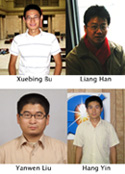 |
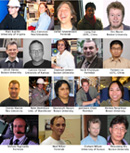 |
Pictured here are the experts who develop, maintain, and monitor the Level 1 Central Track Trigger. This trigger is used for identifying and recording events with high-momentum charged particles such as the muons and electrons used in this search. |
Result of the Week Archive
|
|
Have a safe day!
IDES representative on site Friday
An IDES representative will be on site in the Wilson Hall One East conference room (NE corner) Fridays through the end of March. Small group meetings will occur every 30 minutes, beginning at 11 a.m. and ending with a final meeting at 1 p.m. If you are beginning your furlough week, please fill out a benefit application on site. You may also apply for benefits online or at your local IDES office the week you are on furlough. Please contact Heather Sidman x3326 or Jeannelle Smith x4367 with questions.
International Folk Dance March 13
International Folk Dancing will meet Thursday, March 13, in Wilson Hall's Ramsey Auditorium, this week only while the Barn is occupied. Dancing begins at 7:30 p.m. with teaching and children's dances earlier in the evening and request dancing later on. Newcomers are welcome, and you do not need to come with a partner. Get more information at 630-584-0825 or 630-840-8194 or folkdance@fnal.gov.
FermiGrid classes available
FermiGrid 201:Scripting and Running Grid Jobs course serves as an introductory course for grid computing.
For more information or to enroll
FermiGrid 202:Grid Storage Access course includes lab time.
For more information or to enroll
Folk Club barn dance Sunday
Fermilab Folk Club Barn Dance Sunday, March 16 at 2 p.m. with music by Danny Miller & Friends and calling by Dan Saathoff. More information.
Additional Activities |
|





